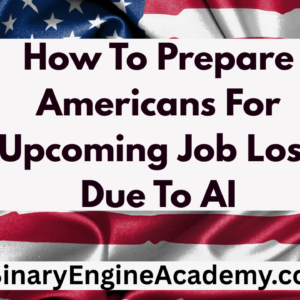How to Prepare Americans for Upcoming Job Loss Due to AI

As artificial intelligence (AI) continues to evolve, it’s becoming increasingly clear that its impact on the workforce will be profound. While AI promises greater efficiency, lower costs, and new industries, it also poses a significant threat to many traditional jobs—especially those involving repetitive, rule-based tasks. For Americans, the challenge ahead isn’t just technological—it’s personal, economic, and cultural.
We’re living in a time where computers and robots are getting smarter every day. It’s not just science fiction anymore — real jobs are being replaced by artificial intelligence (AI). Whether you work in a warehouse, drive a truck, stock shelves, or do office work, there’s a good chance you’ve already seen technology starting to change how things are done.
And here’s the truth: some jobs are going to disappear.
But that doesn’t mean people have to be left behind.
If you’re working hard just to make ends meet, this might sound like another thing to worry about. But there are ways to get ahead of the changes — and even use them to your advantage.
What Jobs Are Most at Risk?
Let’s be honest — it’s the working class that’s getting hit first.
Not all jobs are equally vulnerable to AI automation. Roles that involve routine, repetitive tasks are the most at risk. So how can workers prepare for the AI-driven transformation of the labor market? Here’s a look at what’s coming, and what can be done about it. These include:
Administrative support (data entry, payroll, scheduling)
Transportation (drivers, delivery)
Retail and customer service
Basic manufacturing and warehouse jobs
Even white-collar jobs in finance, legal services, and journalism are starting to see AI encroach on tasks like report writing, contract analysis, and data interpretation.
However, jobs that require emotional intelligence, creativity, physical dexterity, or complex human interaction—like nurses, teachers, therapists, and skilled trades—are less likely to be automated in the near term.
Steps Americans Can Take to Prepare
1. Upskill and Reskill
The single most important move is to never stop learning. Workers must be ready to adapt by acquiring new skills that AI can’t easily replicate. Areas to focus on:
Digital literacy: Basic coding, data analysis, AI tool usage
Creative and critical thinking
Communication and collaboration
Problem-solving and adaptability
Free or low-cost resources are increasingly available through platforms like Coursera, edX, LinkedIn Learning, and community colleges.
2. Focus on Human-Centric Skills
AI may outperform humans in processing data, but it’s not great at empathy or emotional nuance. Workers should lean into:
Healthcare and caregiving
Education and training
Social work and counseling
Entrepreneurship and customer experience
These roles are hard to automate and will likely grow as demand increases for more personal, nuanced services.
3. Embrace Lifelong Career Flexibility
The idea of a single career for life is quickly fading. Americans need to prepare for:
Multiple career changes
A mix of full-time, freelance, and gig work
Building a portfolio of skills rather than a single job title
This means being proactive about career planning, rather than reactive.
4. Advocate for Policy Solutions
Individual effort isn’t enough. The public and private sectors must support workers through:
Universal access to retraining programs
Stronger unemployment and transition support
Portable benefits for gig and freelance workers
Exploration of ideas like Universal Basic Income (UBI)
Jobs most likely to be taken over by AI or machines include:
Driving jobs (like truck drivers or delivery workers)
Warehouse and factory jobs
Office support work (like data entry, payroll, or customer service)
Retail and fast food
Even some construction and maintenance work might get affected by new tech in the coming years.
What Can You Do About It?
Here’s the good news: there are steps you can take to stay ahead.
5. Learn New Skills (Even a Little Helps)
You don’t need a college degree to stay ahead of AI. But picking up new, practical skills will help you stay in demand.
Look into:
Learning how to work with basic computer programs
Getting training in a skilled trade (like HVAC, plumbing, welding)
Picking up certifications (forklift, safety training, basic coding, etc.)
Joining programs at your local community college or job center
There are also free and low-cost courses online — some made just for working people.
6. Choose Jobs That Need a Human Touch
AI can copy a lot of things — but not everything. There are some jobs that still need people, like:
Nurses, home care aides, EMTs
Electricians, mechanics, plumbers
Teachers, daycare workers, social workers
Barbers, chefs, construction crews
These are jobs that can’t be done by a robot. If you’re looking for a new path, this is a solid direction.
7. Be Ready to Pivot
Today’s economy moves fast. That means:
You might switch jobs more than once
You might work a mix of full-time, part-time, or side gigs
You might need to learn new skills every few years
That can feel scary — but it also gives you more control. You don’t have to get stuck. You can move with the times and still make a good living.
8. Speak Up for Fair Policy
Let’s be real: working people didn’t cause this — but they’ll be the first to feel the pain. That’s why we need:
Free or affordable training programs
Stronger unemployment protections
Health benefits that move with you, even if you change jobs
Support for older workers who need to retrain
It’s not just on us — it’s on our leaders, too. We all need to push for better laws, vote for people who care about workers, and hold companies accountable.
Bottom Line: AI Is Coming, But You Can Be Ready
The future is changing fast — but that doesn’t mean you’re out of luck.
Hardworking Americans have always adapted, learned new skills, and fought for their place. This is no different.
You don’t need to be a tech genius. You just need to stay alert, stay flexible, and stay willing to learn. No robot can replace your work ethic, your experience, or your human touch — and that’s something to build on.
AI job displacement isn’t science fiction—it’s already happening. But it doesn’t have to mean mass unemployment. If approached with foresight, resilience, and creativity, the AI era can be one of expanded opportunity rather than scarcity.
The key is preparation. The sooner individuals, companies, and governments act, the better equipped we’ll all be for a future where humans and AI work together, not in competition.
From Zero to $37.76 Billion: How Blogging Built HubSpot Into a Marketing Giant When no one knew their name, HubSpot wrote blog posts. That’s it. No ads, no fancy tricks—just pure, valuable content. Fast forward to 2025, and they’re worth $37.76 billion USD. Their secret? Blogging was the engine. Want to grow like HubSpot? Start creating your blog and start writing. It all starts with one click.




















